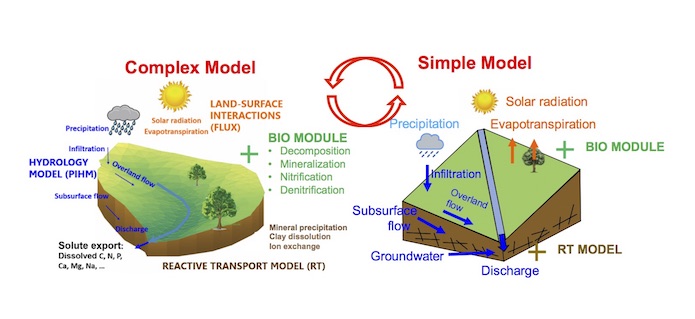New study examines changing soil structures and influence on water resources in US

LAWRENCE — From the garden in your backyard to your local watershed to the entirety of North America, structural changes are taking place in the soil underfoot — and evidence suggests it’s happening faster than previously thought, altering water quality and availability throughout the U.S.
 “Water resources are governed by properties of the soil just beneath the Earth’s surface,” said Pamela Sullivan, assistant professor of geography & atmospheric science at the University of Kansas. “For a long time, we thought properties of these soils are changing at a slow rate. But a lot of evidence is coming to light that they’re responding to climate change and different kinds of land use more quickly. They’re responding quickly because biota in the soil are responding — both plants and microbes — and as they do, they’re changing properties of soil. But we don’t have good measurements of how that happens or the ability to put into models the interactions and feedbacks that will determine water resources in the future.”
“Water resources are governed by properties of the soil just beneath the Earth’s surface,” said Pamela Sullivan, assistant professor of geography & atmospheric science at the University of Kansas. “For a long time, we thought properties of these soils are changing at a slow rate. But a lot of evidence is coming to light that they’re responding to climate change and different kinds of land use more quickly. They’re responding quickly because biota in the soil are responding — both plants and microbes — and as they do, they’re changing properties of soil. But we don’t have good measurements of how that happens or the ability to put into models the interactions and feedbacks that will determine water resources in the future.”
Now, Sullivan is leading work under a $738,562 grant from the National Science Foundation to develop new mathematical models to analyze causes of these observed alterations in soil structure — the arrangement of soil particles and pores — and to examine plant-soil-water responses to varying environmental conditions.
“This work looks at both the biogeochemistry of the soil and how it changes the soil structure,” Sullivan said. “Anyone who cares about what water resources will be like in the future will care about this. Projections and management decisions and understanding of flood dynamics can be influenced by the structure of the soil. If we don’t understand that, we won’t do a good job of understanding how it influences water.”
The KU researcher said the relationship between soil and water was defined by the soil’s matrix of minerals and organic matter and the spaces between, called porosity. These properties are undergoing changes that the new NSF grant will examine by sifting vast amounts of data.
“Changes in precipitation patterns are driving changes in the system itself,” Sullivan said. “It changes the way organic carbon cycles through the system. The structure changes to favor infiltration of water or favor runoff — water running over the land surface. The more overland flow we have, that comes with more erosion and bigger flood events.”
This research embraces what is termed the “Critical Zone” approach to science, involving scientists from a wide array of disciplines from ecologists, pedologists and engineers to hydrologists, who holistically think about Earth’s “living skin” — from the top of the canopy down to depths of circulating groundwater.
Sharon Billings, KU professor of ecology & evolutionary biology and senior scientist with the Kansas Biological Survey, is a co-primary investigator. Daniel Hirmas, formerly at KU and now at the University of California Riverside, Li Li of Pennsylvania State University and Alejandro Flores of Boise State University are also co-investigators.
The grant work will fund four postdoctoral scholars and the training of 10 undergraduate researchers who will help develop a new suite of models to include biological, physical and chemical interactions from local soils in the U.S.
“It’s a lot of number crunching and model building,” Sullivan said. “How do we take data and infer relationships and integrate models at different scales?”
Indeed, the research will tackle changes to the fabric of soil at scales as fine as one plot of land and as large as the entire continent of North America.
“When we think about soils at a fine scale we’re able to understand a lot more of the mechanisms, or what is driving what,” Sullivan said. “It’s important because we can be more detailed and really understand how changes in the way microbes or roots function can control the way carbon cycles and acts as a glue to help form soil structure, and then what that means for the amount of water that can be stored and moved. When we go to watershed scales, we include a lot more dynamics in terms of how water flows downhill and what are the spatial changes in terms of vegetation that might amplify the effect of climate-driven changes in the soil’s fabric. But you lose the fine scale in terms of processes. When we move to continental scales, we take these relationships we already know — like at certain elevations and under certain conditions we expect this to happen — instead of detailing each individual process in terms of soil. All processes are operating at all scales, but some are more important than others in driving what you’re looking at. We’re trying to figure out if something like topography is the most important thing — or is the cycling of carbon by microbes the most important thing at all scales?”
The work will produce new modeling tools to assess environmental sustainability over time and improve the ability to predict land-atmosphere dynamics, subsurface water storage, water table fluctuations and flood events. Further, the research will yield community-accessible tools to examine how soil, hydrologic and biogeochemical feedbacks govern nutrient fluxes.
Sullivan said part of the work would help determine if soil structure forms a positive feedback system with the climate that exacerbates or lessens the severity of climate change.
“Recent evidence published in the journal Nature by co-PI Hirmas and colleagues shows that under wetter climates we’re having an overall reduction in porosity and ability to move water,” she said. “As climates are drying, we see an increase in porosity and the ability to draw in water. As a system is becoming wetter or drier, soil porosities are changing, and the way soil moves and stores water is changing as well. The question we are tackling in this project is, 'What feedback does that give to the climate itself?' Ultimately, when land is interacting with the atmosphere, what is being exchanged is the distribution of water.”
Top image: An approach for upscaling complex model using simple models. Credit: Pamela Sullivan.
Right image: Work under a $738,562 grant from the National Science Foundation will develop new mathematical models to analyze causes of these observed alterations in soil structure — the arrangement of soil particles and pores — and to examine plant-soil-water responses to varying environmental conditions.